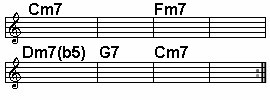Scroll through the lesson and click on notation/video/audio links to load the interactive players.
Please subscribe to get full access to all lessons for only $7.95/month PLUS 1 week free trial.

Riff Interactive lessons are
LESS expensive and
MORE interactive than alternatives!
More Info
|
|

Jazz Guitar For
Beginners
Lesson 7
Lyle:
Last lesson you learned many ways to play chords for this simple 8 bar
progression:
chord
chart

Lyle: In this lesson you'll learn different
scales you can play against this same progression.
Lyle: Here is your looping jam track you'll use
to practice against:
Lyle:
Here's a simple way to play the chords for this
progression:
Lyle:
Here's an example of how you can make up riffs or a solo from those
chords. You can play arpeggios from those chord
shapes:
Lyle: This chord progression is in the key of Eb
Major. Cm is the relative minor of Eb.
Lyle: Fm is the ii minor (Dorian).
Lyle:
Dm7(b5) is the vii (Locrian) in the key of Eb Major.
Lyle: The G7 chord is what can be called a
secondary dominant chord for the key of Eb. Usually the Gm chord would be the
iii chord in Eb.
Lyle: Looking at the progression in a more simple
way, you can say this progression is in the key of Cm!
Lyle:
But the G7 chord, acting as the V chord in Cm throws a red flag up, signaling
you to be aware and play a C harmonic minor scale during that
chord.
Lyle: Now learn these scale patterns, then I'll
show you a way to use them to make a
solo.
Lyle: Here's the Eb Major
scale:
Lyle: Another major scale that belongs to the key
of Eb is the Ab Lydian mode, the 4th mode in Eb.
Lyle:
Try those scales against the looping jam track and you'll hear how well they
sound with the progression.
Lyle: During the Dm7(b5) chord I'll have you
playing the D Locrian mode:
Lyle:
During the G7 chord you'll want to play the C harmonic minor
scale:
wayne: Could
you also play C harmonic minor over the Dm7b5?
Lyle: Yes wayne.
Lyle: Now here's how you can put these together
over the progression:
Lyle: Here's a video of
it:
Lyle: I
also forgot to mention you can use the C minor pentatonic scale over any and all
of the progression!
TomA: I figured
that out already :)
Lyle: The C natural/relative minor scale works
great over any and all of the progression too. It is called the C Aeolian
mode:
Lyle:
The use of "double-stops" (any two notes played together at the same time)
always sounds good in jazz. Here's a simple way to practice playing the
double-stop technique by ascending the C minor scale:
LiveOak:
Oh wow! So THAT is how Jazz players get that sound!
Thanks!
Lyle: A
jazz legend named Wes Montgomery is famous for this sound. He could play
anything using double-stops.
Lyle: In this example of double-stops you're just
playing octaves. I like this sound because it makes the tone so much fatter.
Here's a video of this.
Lyle:
That should give you some cool ideas to work on.
LiveOak: Yes!
wayne: What a lesson! Thanks Lyle!
Lyle: Good time to take a
break. I'll see you at the next lesson!
|
<< load notation from left
|
|
<< load audio from left
|
<< load audio from left
|